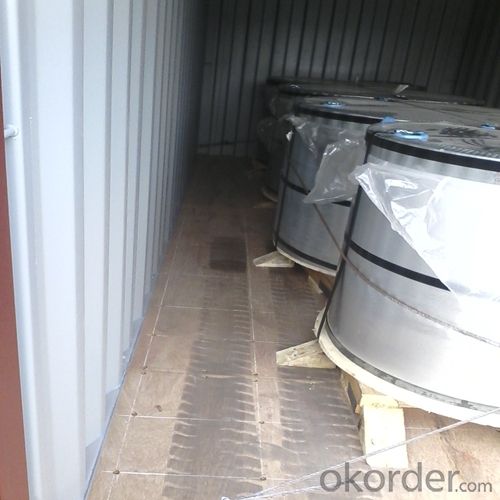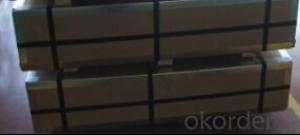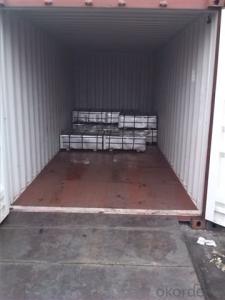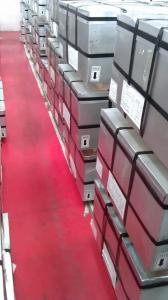Tinplate ETP for Milk Powder Cans with SPCC or MR Steel
- Loading Port:
- Qingdao
- Payment Terms:
- TT OR LC
- Min Order Qty:
- 25 m.t.
- Supply Capability:
- 30000 m.t./month
OKorder Service Pledge
OKorder Financial Service
You Might Also Like
1.Structure of Tinplate ETP for Milk Powder Cans with SPCC or MR Steel Description
Electrolytic Tinplate is a thin steel sheet coated by tin. It has an extremely beautiful metallic luster as well as excellent properties in corrosion resistance, solder ability, and weld ability.
2.Main Features of the Tinplate ETP for Milk Powder Cans with SPCC or MR Steel
Electrolytic Tinplate undoubtedly enjoys the pride of place as a packaging medium especially for food. It owes its unique position to its "nine layer sandwich structure", each of which contributes to its eminence as a packing material. The steel base of electrolytic tinplate provides the necessary strength and formability for can fabrication. The tin-iron alloy layer provides the bond between the steel and free tin layer. The free tin layer is not only responsible for the attractive bright finish and ease of solderability but is also non-toxic- a factor of vital importance in food packaging!
Tinplate is also widely used for making all types of containers such as food cans, beverage cans, and artistic cans, tea cans, painting cans, chemical package cans and dry food package cans, metal printing etc. Its applications are not limited to containers; recently, electrolytic tinplate has also been used for making electrical machinery parts and many other products.
3.Tinplate ETP for Milk Powder Cans with SPCC or MR Steel Images



4.Tinplate ETP for Milk Powder Cans with SPCC or MR Steel Specification
Standard: ISO 11949 -1995
Material: SPCC
Thickness:0.175mm
Width: 600mm
Temper: T4
Annealing:CA
Coil Inner Diameter: 508mm
Weight: 6-10 tons/coil 1~1.7 tons/sheets bundle
Passivation:311
Oil: DOS
Surface: Finish
5.FAQ of Tinplate ETP for Milk Powder Cans with SPCC or MR Steel
1. What is the delivery time for your prime quality tinplate?
Usually 35 days after order confirmation.
2. What is your Minimum Order Quantity?
Usually MOQ is 50tons for one single size, for trial order, it can be 25 tons.
3. What is the payment term?
The most common we use is L/C at sight or TT. We can also try use other terms.
- Q: What are the main applications of tinplate in the tobacco industry?
- The main applications of tinplate in the tobacco industry include the production of cigarette packaging, such as cigarette boxes and tins, which provide a protective and durable barrier for the tobacco products. Tinplate is also used for the inner lining of cigarette packets to maintain the freshness and quality of the tobacco. Additionally, tinplate is utilized for the production of cigarette rolling papers, filters, and other tobacco-related accessories.
- Q: What are the common packaging formats for tinplate?
- The common packaging formats for tinplate include cans, containers, and tins.
- Q: What kind of metal material is tinplate? How much is the current price per ton?
- Tinplate is a tin covered with tin, it is not easy to rust, also known as tin iron.
- Q: How is tinplate used in the food industry?
- Tinplate is commonly used in the food industry for packaging purposes. It is a thin steel sheet coated with a layer of tin, which provides a protective barrier against corrosion and maintains the quality and freshness of food products. Tinplate cans and containers are widely used for packaging canned fruits, vegetables, meat, fish, and other processed food items. The tin coating also prevents any interaction between the food and the metal, ensuring that the taste, flavor, and nutritional value of the food are preserved. Additionally, tinplate is easy to sterilize, making it suitable for products that require high levels of hygiene and long shelf-life, such as canned soups and sauces.
- Q: Cookies with tinplate packaging has what advantage?
- Barrier: tinplate cans have excellent barrier properties than any other materials are excellent, gas barrier properties, moisture resistance, shading and aroma were good, and the sealing is reliable, reliable protection products.
- Q: Can tinplate be used for packaging wine or spirits?
- Yes, tinplate can be used for packaging wine or spirits. Tinplate is a type of steel coated with a thin layer of tin, which provides excellent corrosion resistance and protection against light. It is commonly used for packaging food and beverages, including wine and spirits, due to its durability and ability to maintain product quality.
- Q: What are the different types of tinplate seams?
- There are three main types of tinplate seams: the lap seam, the double seam, and the triple seam. The lap seam is formed by overlapping the tinplate and soldering the edges together. The double seam involves folding the edges of the tinplate over each other and then crimping them together. Lastly, the triple seam is created by folding the edges of the tinplate over each other twice and crimping them together.
- Q: Is to buy canned tinplate or aluminum
- Tinplate, our company sells tinplate
- Q: Can tinplate packaging be used for aerosol products?
- Yes, tinplate packaging can be used for aerosol products. Tinplate is a commonly used material for producing aerosol cans due to its strength, durability, and resistance to corrosion. It provides an efficient barrier against moisture and oxygen, which helps to maintain the quality and shelf life of the aerosol product inside. Additionally, tinplate packaging is easily recyclable, making it an environmentally friendly choice for aerosol products.
- Q: Can tinplate packaging be used for stationery products?
- Yes, tinplate packaging can be used for stationery products. Tinplate is a durable and versatile material that provides protection and aesthetic appeal, making it suitable for packaging various stationery items like pens, pencils, erasers, or paper clips. Additionally, tinplate packaging can be custom designed and printed to enhance branding and create a unique look for stationery products.
Send your message to us
Tinplate ETP for Milk Powder Cans with SPCC or MR Steel
- Loading Port:
- Qingdao
- Payment Terms:
- TT OR LC
- Min Order Qty:
- 25 m.t.
- Supply Capability:
- 30000 m.t./month
OKorder Service Pledge
OKorder Financial Service
Similar products
Hot products
Hot Searches
Related keywords




























